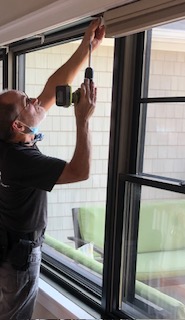The Installer

An installer obviously needs to know how to hang blinds but a homeowner could do this as well.
What differentiates the pro from the homeowner or handyman can be summed up as proficiency plus efficiency. Of these, the first to master is proficiency. You must get it right or your efforts won’t count for much.
You can’t afford to spend more time on a job than is required to deliver the correct result. This does not mean rushing! So, aim for efficiency.
First, learn RIGHT, then learn FAST!
Proficiency
There is a vast and ever growing range of products available and you must understand them. Know how to install them and how they operate.
Understand the tools, hardware and supplies you need for the job. Custom blinds come with the necessary brackets but the screws supplied are of the ‘best case scenario’ variety. Make sure to carry:
- Self-piloting screws
- Various sized longer screws. I always have 2 & 3 inch hex heads.
- Anchors(mollies) for drywall and concrete.
- Toggle bolts
Always try to screw into something solid. Often, longer screws can contact a stud where the ones the manufacturer supplied cannot. Develop techniques for special situations.
Lay out your work carefully.
- Products should be ‘tagged’ by room name. Make sure the correct coverings are in the windows.
- Check measurements and job notes before any brackets go up. Verify inside vs outside mount. Designers might specify an outside mount for aesthetic reasons even though adequate depth is available inside.
Efficiency
Carry a small tool bag with all the tools and fasteners needed for 90% of the jobs. You will reduce trips to your vehicle. If you must go to your vehicle, try not to go empty-handed.
A small 2 or 3 step ladder is all you will need for most of your work. A lightweight aluminum step with a small shelf on top is my favorite. Drill extra holes to accomodate all your tools and bits. Make sure to have longer ladders in your vehicle.
Leave infrequently used tools in your vehicle:
- Hacksaw
- Battery operated power miter saw
- Additional hand tools
Carry your drill in a belted holster, with an extra battery in a pouch.
Charge your batteries in your vehicle. Use a DC/AC inverter to power your charger. It’s easy to leave behind a charger that you plugged into a customer’s outlet. These unnecessary return trips waste a lot of time($).
Develop a quick way to safely open boxes. Use the method in a production-line style. Dispose of wrappers, bags, foam and bubble wrap as you unpack the products. No sense in double-handling the trash.
Neatness DEFINITELY counts. Use drop cloths, dustpan and small portable vacuum as necessary.
